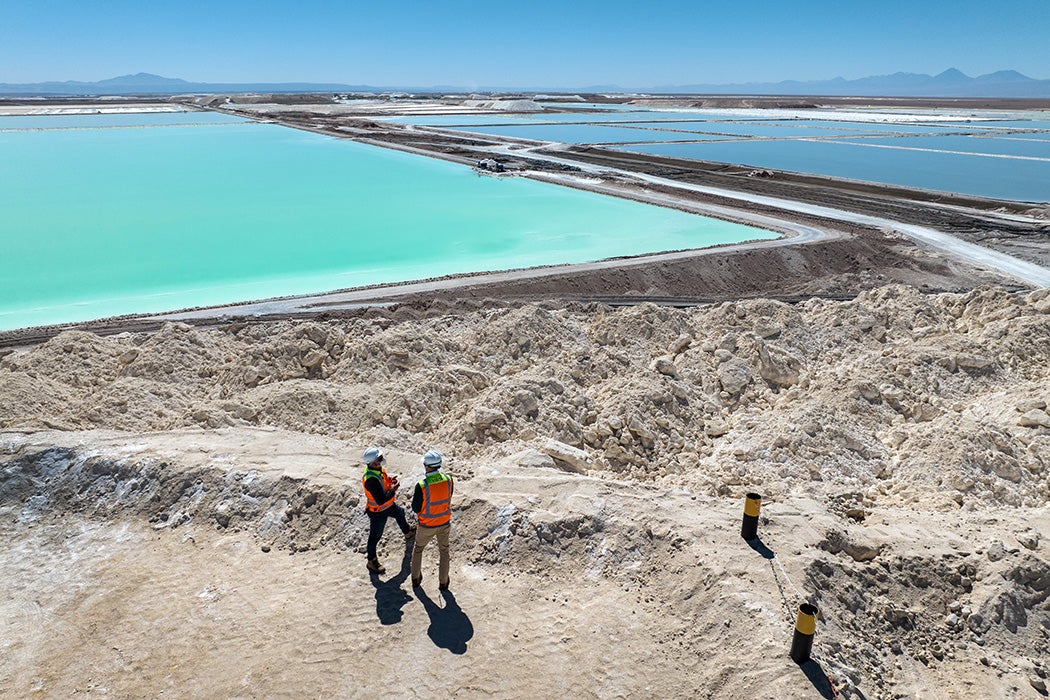Lithium (Li, atomic number 3) is an alkali metal. After hydrogen and helium, it’s the third lightest element there is. It has the lowest density of all metals and “reacts vigorously with water.”
Increasingly important as a strategic resource, lithium has become one of the fundamental raw materials for a renewable energy transition to a less fossil-fuel dependent world. Rechargeable lithium-based batteries in particular are being used for the ever-increasing number of electronic vehicles and devices. And fire departments are dealing with explosive lithium-ion battery fires caused by damage, poor storage, and/or improper charging.
Global lithium production tripled between 2010 and 2020.
About three-quarters of the world’s lithium production is used for batteries. Ceramics and glass production, where it’s used as a flux, take the next biggest proportion of lithium, about 14 percent. Lithium is also used for lubricating greases, continuous casting mold flux powders, polymers, air treatment, and some purposes that may surprise people.
Lithium deuteride, for instance, is a combination of lithium and deuterium. It’s the fuel for the nuclear reaction in a thermonuclear bomb. The most explosive US atmospheric nuclear test, which turned out to be much more powerful than expected, was the Bravo test of 1954; it was the first use of the isotope Lithium-7 as fuel.
Lithium also has medicinal uses: lithium salts have been used as mood stabilizers for sufferers of bipolar disorder and other mental illnesses for half a century now.
As geographers Felix M. Dorn and Gernando Ruiz Peyré explain, one of the world’s major sources of lithium is the “lithium triangle” of Argentina, Bolivia, and Chile. Lithium has been called the “gold of the twenty-first century” and the A-B-C triangle has been labeled the “Saudi Arabia of lithium.” Such descriptions should raise alarms. Gold rushes have been ecologically and socio-culturally devastating, especially for Indigenous peoples. Single-resource extractive economies typically go hand-in-hand with authoritarian regimes characterized by extreme disparities in wealth.
The lithium triangle produces more than half of the world’s lithium. The region also holds “approximately 85 percent of accessible brine deposits”—the easiest and cheapest way to extract lithium is via evaporation from continental brines. These factors give “a major competitive advantage” because of the low cost of extraction and processing. Continental brines are reservoirs typically found under salars, or salt flats. Salars are the historic result of salt lakes.
Dorn and Peyré explain that Bolivia’s Salar de Uyuni, Chile’s Salar de Atacama, and a “series of smaller flats in northwest Argentina” are where the “world’s largest resource deposits are located.” Evaporation, or concentration, of the brine, as practiced in this region is slow and very water intensive, raising serious questions about its sustainability. Otherwise, the environmental impact of brine extraction is “significantly lower than conventional large-scale mining, [but] remains enmeshed in controversy” regionally.
Another way to get lithium is by mining hard rock ores. Australia leads the world in this type of lithium-mining, write Dorn and Peyré. China is the second largest lithium-mining country, as well as the next largest source of continental brines after the lithium triangle.
Weekly Newsletter
Lithium isn’t scarce. It’s found in sea water, geothermal brines, and oilfield brines, which are deep brine pockets penetrated by oil drilling. But since these are so much more diluted sources of the metal, extraction from such sources is more expensive and unwieldy. Various direct lithium extraction (DLE) technologies are being developed to exploit these alternate sources in the future.
In the case of Argentina, which in recent years has provided just over half of the lithium imported by the US, Dorn and Peyré call the Saudi Arabia analogy “exaggerated speculation.” There may be too much lithium around the world for one country or a consortium of countries (on the OPEC model) to control it. The price of battery-grade lithium leaped to over $80,000 per ton in 2022 but then dropped to just over $13,000 per ton at the beginning of 2024.







